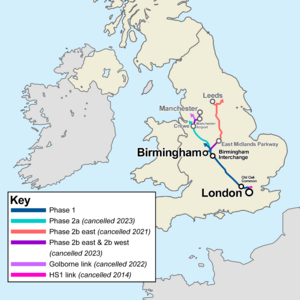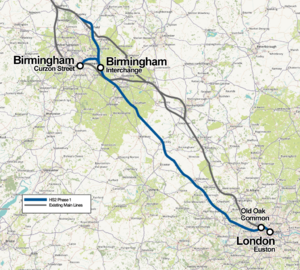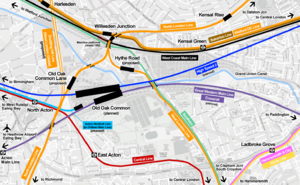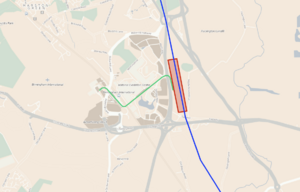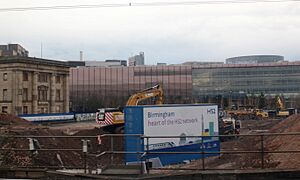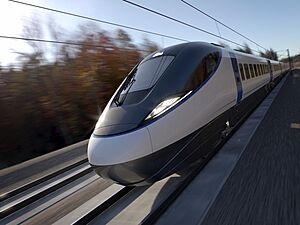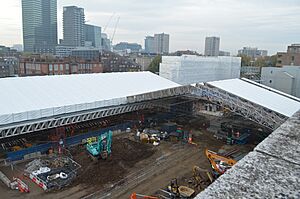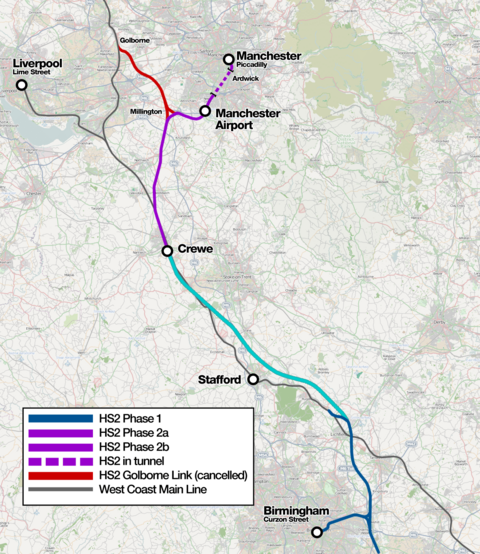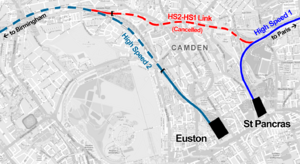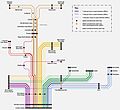High Speed 2 facts for kids
Quick facts for kids High Speed 2 |
|
|---|---|
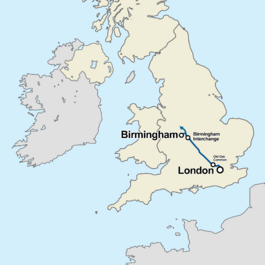
The planned extent of HS2 as of October 2023
|
|
| Overview | |
| Status | Under construction |
| Locale | |
| Termini | London Euston Birmingham Curzon Street |
| Connecting lines | West Coast Main Line |
| Stations | 4 |
| Service | |
| Type | High-speed railway |
| System | National Rail |
| History | |
| Commenced | 2017 |
| Planned opening | Unknown |
| Technical | |
| Line length | 230 km (140 mi) |
| Number of tracks | Double track |
| Track gauge | 1,435 mm (4 ft 8 1⁄2 in) standard gauge |
| Loading gauge | UIC GC |
| Electrification | 25 kV 50 Hz AC overhead line |
| Operating speed | 360 km/h (225 mph) maximum, 330 km/h (205 mph) routinely |
High Speed 2 (HS2) is a new high-speed railway being built in England. Construction started in 2019. The main part of the line runs between Handsacre in southern Staffordshire and London, with a special branch line going to Birmingham. HS2 is the second railway built specifically for high-speed trains in Britain. The first was High Speed 1, which connects London to the Channel Tunnel.
New high-speed tracks directly serve London and Birmingham. Trains going to cities like Glasgow, Liverpool, and Manchester use a mix of the new HS2 tracks and the older West Coast Main Line. Most of the project was supposed to be finished by 2033. However, in 2025, the completion date was officially delayed by the Secretary of State for Transport, Heidi Alexander.
The new tracks are being built between London Euston and Handsacre, which is near Lichfield. At Handsacre, HS2 connects to the West Coast Main Line. New stations are planned for Old Oak Common in northwest London, Birmingham Interchange near Solihull, and Birmingham city centre. The special trains are designed to travel up to 360 km/h (220 mph) on HS2 tracks. On older tracks, they slow down to 200 km/h (125 mph).
The original plan for HS2 in 2013 was much bigger. It was going to split into eastern and western branches north of Birmingham. The eastern branch would have gone to Leeds and York, and the western branch to Manchester. But between 2021 and 2023, most of these plans were cancelled. Now, only the London to Handsacre and Birmingham section is being built.
HS2 has both supporters and opponents. Supporters believe it will help more people travel by train, especially as passenger numbers grow. They also think it will encourage more people to choose trains over cars or planes. Opponents worry about the environmental impact and whether the project is worth the money it costs.
History of HS2
Modern high-speed rail came to the UK in 2003 with the first part of High Speed 1 (HS1). This line, then called the Channel Tunnel Rail Link, was 67-mile-long (108 km) and connected London to the Channel Tunnel. In 2009, the Department for Transport (DfT) suggested looking into a second high-speed line. A new company, High Speed Two Limited (HS2 Ltd), was created to develop it.
In December 2010, a Y-shaped route from London to Birmingham, with branches to Leeds and Manchester, was proposed. This plan aimed to reduce the impact on the environment.
In January 2012, the government announced that HS2 would be built in two main parts. Laws were passed to allow construction. Phase 1, from London to the West Midlands, was approved in February 2017. Phase 2a, from the West Midlands to Crewe, was approved in February 2021. The plans for Phase 2b, which included lines to Manchester, were paused.
One main goal of HS2 is to make more space on the railway network. By moving fast express trains to HS2, older lines can be used for more local trains. This helps more people travel as passenger numbers increase. Network Rail thought building a new high-speed railway would be better and cause less disruption than upgrading the old lines. The DfT also believed that better train connections would help the economy. They hoped that faster journeys and more space would encourage people to switch from flying or driving to taking the train.
Oakervee Review and Project Changes
On August 21, 2019, the DfT asked for an independent review of the project. Douglas Oakervee, who had been a chairman for HS2, led this review. The review was published on February 11, 2020. The Prime Minister confirmed that HS2 would continue as planned. Oakervee concluded that HS2 was still needed to provide more space and reliability on the rail network. He recommended the project continue, but with a focus on reducing costs.
On April 15, 2020, construction companies were officially allowed to start work.
In July 2023, a report gave Phases 1 and 2A a "red" rating. This meant that successfully finishing the project seemed very difficult. It suggested there were big problems with the plan, timeline, budget, and benefits. The report said the project might need to be re-planned. Ideas like reducing train speeds and how often they run, and cutting costs, especially for Phase 2b, were considered.
A report in January 2024 from the House of Commons Public Accounts Committee said that HS2 now offered "very poor value for money" for taxpayers. This was after parts of the project had been cancelled.
Integrated Rail Plan
On November 18, 2021, the government released its Integrated Rail Plan. This plan greatly changed parts of the HS2 project, especially the eastern leg.
The original eastern leg would have connected to the East Coast Main Line near York and had a branch to Leeds. It also included a branch to the Midland Main Line near Derby. The new plan largely removed the HS2 eastern section. Instead, a branch from Coleshill near Birmingham would go to East Midlands Parkway station. From there, trains would use the existing Midland Main Line to reach Nottingham, Derby, Chesterfield, and Sheffield.
Upgrades to the East Coast Main Line were suggested to make journeys faster from London to Leeds and Newcastle. Services from Birmingham to Leeds and Newcastle were planned to use the remaining part of the HS2 eastern leg.
In June 2022, a planned connection called the Golborne spur was removed from the Crewe-to-Manchester plans. Without this link, trains to Scotland would join the West Coast Main Line further south at Crewe, instead of near Wigan.
Cancellation of Phase 2 (October 2023)
In July 2023, the Infrastructure and Projects Authority again gave the first two phases of HS2 a "red" rating. This meant that finishing the project successfully seemed very difficult. HS2 Ltd's chief executive, Mark Thurston, announced he was leaving on July 13.
In October 2023, the Prime Minister, Rishi Sunak, announced that Phase 2 would be cancelled. This meant the new high-speed track would only run from London to Handsacre, northeast of Birmingham, with a branch to central Birmingham. The building of Euston station would depend on money from private companies. If funding was found, HS2 Ltd would be in charge of building the station access tunnel. Euston station was first planned to have 11 platforms for HS2 trains. This was reduced to six platforms in October 2023. This change means fewer trains (9–11 per hour) can use the station, instead of the 18 trains per hour the HS2 track could handle.
Sunak said the £36 billion saved by not building the northern part of HS2 would be spent on roads, buses, and railways across the country, under a plan called "Network North." These projects would be in places from southern Scotland to Plymouth. About 30 percent of the money saved would go to railway projects.
In January 2024, the leader of the opposition, Keir Starmer, said that a future Labour government would not be able to restart Phase 2 because contracts would have been cancelled. This was confirmed in April 2024 by Louise Haigh, the shadow transport minister.
New Leadership and Review (2024-2025)
In December 2024, Mark Wild became the new chief executive of High Speed Two Limited. He looked closely at the project. On March 31, 2025, he wrote to the Transport Secretary, Heidi Alexander. He said that the organization had "failed in its mission to control costs and deliver to schedule" and that the situation was not sustainable. He estimated that only about one-third of the project was complete, even though it was planned to be three-quarters done.
He mentioned that events like the COVID-19 pandemic, Brexit, and the war in Ukraine had caused problems. But he also pointed to three main issues:
- Construction started too early, before designs were fully ready. The focus was on speed rather than efficiency.
- Many contracts were signed before companies fully understood the risks. This meant contractors were not strongly encouraged to keep costs down.
- HS2 Ltd was not set up to actively manage the building work closely.
This was followed by the Stewart Review, which looked at how HS2 was managed. It was published on June 18, 2025. The review said that the idea of building the "best and fastest" railway had made it hard to control costs. It also noted that the project's goals kept changing, pushing for faster building before designs were ready.
On the same day, the Transport Secretary told Parliament that she accepted all the review's suggestions. She called the situation "an appalling mess." She confirmed that meeting the 2033 end date was impossible. She said "Billions of pounds of taxpayers’ money has been wasted by constant scope changes, ineffective contracts and bad management." In the future, the project's main goal would be to build at the lowest reasonable cost, even if it took longer. She confirmed that tunnelling to the Euston station would happen.
Route of HS2
London to Handsacre and Birmingham
HS2 runs next to the West Coast Main Line (WCML) and joins it at Handsacre. The line goes from Euston railway station in London to a connection with the WCML near Handsacre in Staffordshire. There is also a branch line to a new station at Birmingham Curzon Street. New stations are also being built at Old Oak Common in northwest London and Birmingham Interchange near Solihull. The section between Old Oak Common and the West Midlands is expected to open around 2030. The link to Euston is planned to follow between 2031 and 2035. The high-speed track, including the Birmingham branch, is 225 kilometres (140 mi) long. It runs alongside the WCML and the Chiltern Line.
When it opens, HS2 trains will travel from London to Birmingham in 49 minutes and to Birmingham Interchange in 38 minutes. Trains will go to other places using both HS2 and older tracks. Journeys to Liverpool will take 1 hour 50 minutes, to Glasgow 4 hours, and to Manchester 1 hour 40 minutes. Trains will use HS2 tracks to Handsacre, then switch to the West Coast Main Line.
The route from London starts at Euston station. It enters a twin tunnel near Mornington Street Bridge. After Old Oak Common station, trains go through a second 8-mile (13 km) tunnel. The line then crosses the Colne Valley Regional Park on the Colne Valley Viaduct. It then enters a 9.8-mile (15.8 km) tunnel under the Chiltern Hills, coming out near South Heath. The route generally follows the A413 road and the London to Aylesbury Line. A "cut-and-cover" tunnel is being built under farmland. This means digging a trench, building the tunnel, and then covering it with soil. This helps reduce noise and visual impact. After passing Aylesbury, the route follows the path of the old Great Central Main Line. It then crosses open countryside through South Northamptonshire and Warwickshire, passing south of Southam. After a tunnel under Long Itchington Wood, the route goes through rural areas between Kenilworth and Coventry, entering the West Midlands.
Birmingham Interchange Station is on the edge of Solihull, close to major roads like the M42, M6, and A45. These roads are crossed by bridges. The station is next to Birmingham Airport and the National Exhibition Centre. North of the station, near Coleshill, there will be a complex junction with six tracks. This links the HS2 Birmingham city centre branch with the main line. The main line continues north to connect with the WCML at Handsacre. The Birmingham city centre branch goes along the Water Orton rail corridor and through a tunnel past Bromford.
Connections to Other Lines
West Coast Main Line
A key part of the HS2 plan is that the new high-speed track connects to the existing West Coast Main Line at Handsacre, north of Birmingham. This allows HS2 trains to continue north on the older tracks. This is the only connection between the new and existing tracks. This connection means HS2 services can reach Liverpool, Manchester, and Glasgow using both new high-speed tracks and the existing West Coast Main Line. The special trains are designed to work on both types of tracks.
Stations
Central London: Euston Station
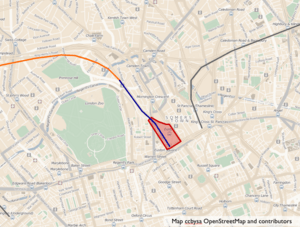
HS2 is planned to share its southern end with the West Coast Main Line at London Euston. The station is being redesigned to include six new HS2 platforms and a concourse. There will be better connections to the nearby Euston Square tube station, which serves the Circle, Hammersmith & City, and Metropolitan underground lines. The government has said that this part of the project will only start if private companies agree to provide funding.
West London: Old Oak Common Station
Old Oak Common station, located between Paddington and Acton Main Line station, is currently under construction. It is expected to be finished before Euston. It will be the temporary London end point for HS2 until Euston is ready. There will be connections to the Elizabeth line, Heathrow Express to Heathrow Airport, and the Great Western Main Line to Reading, South West England, and South Wales. Old Oak Common station will also connect to London Overground stations at Old Oak Common Lane and Hythe Road through easy transfers.
Birmingham Airport: Birmingham Interchange
Birmingham Interchange will be a station where trains pass through, located in suburban Solihull. It is within a triangle of land surrounded by the M42, A45, and A452 highways. A special people mover will connect the station to the National Exhibition Centre, Birmingham Airport, and the existing Birmingham International railway station. This people mover can carry over 2,100 passengers per hour in each direction. The AirRail Link people-mover already runs between Birmingham International station and the airport. There is also a plan to extend the West Midlands Metro tram service to the station.
In 2010, the chief executive of Birmingham Airport, Paul Kehoe, said that HS2 was important for increasing flights from the airport. He believed it would bring more passengers from London and the South East, as HS2 would cut travel times from London to Birmingham Airport to under 40 minutes.
Birmingham City Centre: Curzon Street Station
Birmingham Curzon Street will be the final station at the end of a branch line that connects to the main HS2 line at Coleshill. A station with the same name existed on this site from 1838 to 1966. The old, historic station building will be kept and restored.
The site is right next to Moor Street station and about 400 metres (0.25 mi) northeast of New Street station. Passengers can easily walk between Moor Street and Curzon Street. A walkway connects Moor Street and New Street. In September 2018, one of Birmingham's oldest pubs, the Fox and Grapes, was taken down to make way for the new developments. The West Midlands Metro tram service will also be extended to serve this station.
Planning for the Fazeley Street area of Birmingham has changed because of HS2. The new Eastside development will include a new museum area. The original station building will become a new photography museum, facing a new Curzon Square.
Work to clear the site for construction began in December 2018. The new station is expected to have a zero-carbon rating and over 2,800 square metres (30,000 sq ft) of solar panels.
Tunnelling Work
There are five twin-bore tunnel sections on the route from London to Birmingham. The Euston tunnel will take passengers from Euston railway station to Old Oak Common station. The Northolt tunnel covers the area between Old Oak Common and the Colne Valley Viaduct. The Chiltern tunnel is the longest tunnel on the route, travelling 10 miles (16 km) under the Chiltern Hills. The Long Itchington Wood tunnel is the shortest and goes under an ancient woodland. The Bromford tunnel will take trains into Birmingham city centre.
Euston Tunnel Progress
In April 2023, HS2 announced that work on the Euston tunnels, linking Old Oak Common to Euston, was being delayed. Tunnel-boring was rescheduled to start in summer 2025. In October 2023, the government announced that any Euston station would not be funded by the government. However, in May 2024, the government was reportedly ready to pay about £1 billion for the tunnelling costs to avoid more delays. They plan to get this money back from other developments around the Euston station site.
Northolt Tunnel Progress
The Northolt tunnels are being built using four large tunnel boring machines (TBMs). Two TBMs are digging from West to East, and two from East to West, meeting in the middle. TBMs Sushila and Caroline started from West Ruislip in October 2022. The third TBM, Emily, started in February 2024, and the fourth, Anne, followed in April 2024. All the tunnels are expected to be finished by June 2025.
Chiltern Tunnel Progress
The 10-mile (16 km) Chiltern tunnels were planned to take three years to dig, using two 2,000-tonne (2,000-long-ton; 2,200-short-ton) tunnel boring machines (TBMs). Work on a 17-metre (56 ft)-high wall at the southern entrance of the tunnel was finished in July 2020. The tunnels are lined with concrete sections made at a special factory nearby. Tunnelling began in May 2021 with TBM Florence, which moved up to 15 m (49 ft) per day. The second TBM, Cecilia, started in July 2021. Florence finished its tunnelling in late February 2024, and Cecilia finished in March 2024.
Long Itchington Wood Tunnel Progress
In December 2021, TBM Dorothy started digging under Long Itchington Wood. It finished the first tunnel in July 2022. It was then moved back to its starting point to dig the second tunnel next to it. Dorothy began the second tunnel in November 2022 and finished it in March 2023.
Bromford Tunnel Progress
The Bromford tunnels, from Water Orton to Birmingham, are being dug by TBMs Mary Ann and Elizabeth. Mary Ann started in August 2023 and finished in May 2025. Elizabeth started in March 2024 and is expected to finish in autumn 2025.
Main Construction Work
The main construction stages officially began on September 4, 2020, after some delays. The civil engineering work for Phase 1 is worth about £6.6 billion. This includes preparing the ground, with over 8,000 boreholes dug for investigation. As of March 2025, no track had been laid, and about one-third of the civil engineering construction work was complete.
Euston Station Construction
In October 2018, demolition began on the old train sheds at Euston station. This cleared the way for construction at the start of the station and for twin 8-mile (13 km) tunnels to West Ruislip. In January 2019, the taxi rank at Euston was moved to a temporary spot so that two tower blocks could be demolished. In June 2020, workers finished taking down the western ramp and canopy of the station.
In March 2023, the government delayed work on Euston station. They said this was to "manage inflationary pressures" and create a more affordable design. The priority became getting services running between Birmingham and Old Oak Common. The Elizabeth line would provide transport between Old Oak Common and central London until at least 2035, which is the earliest Euston would be ready under the new plans.
Colne Valley Viaduct
The Colne Valley Viaduct is a 2.1-mile (3.4 km)-long bridge that will carry the line over the Colne Valley Regional Park in Hillingdon, West London. This bridge is located between the Northolt and Chiltern tunnels. A special bridge-building machine started work in May 2022. The last part of the bridge deck was put in place in September 2024. The viaduct is expected to be fully finished in May 2025.
Old Oak Common Station Construction
Construction of Old Oak Common station began in June 2021.
How HS2 Will Operate
Earlier government plans suggested that by 2033, HS2 would run up to 18 trains an hour to and from London. The 2020 business plan included a possible service schedule, but this was never finalized. Some services were planned to run as two connected train units that would then split to go to different northern cities.
Operator and Fares
The company responsible for running and maintaining High Speed 2 is Avanti West Coast. This company, a partnership between FirstGroup and Trenitalia, was chosen in December 2019. Avanti West Coast will handle tickets, trains, and maintaining the railway. Their first contract is for the first three to five years of HS2's operation.
The government has said that ticket prices will be similar to those on existing railways. They expect HS2 to attract enough passengers so that it won't need to charge higher "premium" fares. Paul Chapman, in charge of HS2's public relations, suggested that last-minute tickets might be sold at a discount. He said that if trains are leaving often, like every five or ten minutes, and there are empty seats, tickets could be sold for £5 or £10 at a standby rate.
Capacity of the Line
HS2 was planned in the 2010s to carry up to 26,000 people per hour. The line would be used very often, with up to 17 trains per hour going to and from Euston. Since all trains would travel at the same speed, more people can be carried. This is because faster trains won't need to slow down for slower freight or commuter trains.
By moving the fastest services to HS2, more space becomes available on the West Coast Main Line. This allows for more slow freight trains, local, regional, and commuter services. Andrew McNaughton, Chief Technical Director, said that as a railway just for passengers, HS2 can carry more people per hour than two motorways. He called it "phenomenal capacity."
Infrastructure Details
The DfT report in March 2010 set out the requirements for the high-speed line. It will be built to a European standard size, like HS1. It will also follow European Union technical standards for high-speed rail. HS2 is being built with a UIC GC loading gauge, which means trains can be larger. It is designed for a maximum speed of 400 km/h (250 mph). Initially, trains would reach a maximum speed of 360 km/h (225 mph).
The signalling system will be based on the European Rail Traffic Management System (ERTMS), with signals inside the train cab. This is needed because signals next to the track are hard to see at speeds over 200 km/h (125 mph). ETCS Level 2 will be used, with automatic train operation (ATO) at GoA2. This means trains will be semi-automatic, with drivers handling doors, driving if needed, and emergencies. GSM-R will be used for communication.
The line will be powered by 25 kV 50 Hz AC electricity from overhead lines.
Most open sections of the line will use pre-cast slab track. This system is supplied by PORR. In tunnels and stations, concrete track will be poured in place.
Platform height was initially planned to be 760 millimetres (2 ft 6 in), a European standard. However, new HS2 stations will use a platform height of 1,115 millimetres (3 ft 7.9 in) to make it easier for people to get on and off trains, allowing for step-free access. Trains continuing onto the older rail network will use platforms at the standard UK height of 915 millimetres (3 ft 0 in).
Rolling Stock (Trains)
A process to choose a company to build and maintain 54 high-speed trains took place between 2017 and 2021. In December 2021, a £1.97 billion contract was given to a partnership between Alstom and Hitachi Rail. This contract covers designing, building, and maintaining the trains for an initial 12 years. The trains will be based on an updated version of the Zefiro V300 design.
The train bodies will be built at the Hitachi factory in Newton Aycliffe. The bogies (wheel sets) will be made at the Alstom factory in Crewe. The final assembly of the train bodies, bogies, and other systems will happen at Alstom in Derby. The train design is still being finalized, with full production expected to start around 2027.
The trains will have a maximum speed of at least 360 km/h (225 mph) and be 200 metres (660 ft) long. Two units can be joined together to make a 400-metre (1,300 ft) long train.
Maintenance Depots
A train maintenance depot will be built at Washwood Heath in Birmingham.
The maintenance depot for the railway tracks and equipment will be built roughly halfway along the route, north of Aylesbury, between Steeple Claydon and Calvert. This site is next to where HS2 crosses the East West Rail route.
Journey Times
The DfT's latest estimates for journey times to some major cities have been shared in various government documents.
HS2 Services from London
Since the cancellation of Phase 2 of HS2, services and journey times will be different from the original plans. In December 2024, Rail Minister Lord Hendy stated that HS2 services had not been fully decided. He also said that Euston Station will have six HS2 platforms. There are also ideas to upgrade Pendolino trains to 155 mph (249 km/h) for use on both HS2 and WCML tracks to improve journey times. Pendolino trains are expected to be in use until 2046 with upgrades.
| London to/from | Fastest journey time before HS2 (hrs:min) |
Estimated time with full HS2 including Phase 2 (hrs:min) |
Estimated time reduction with Phase 2 active (min.) |
|---|---|---|---|
| Birmingham | 1:21 | 0:52 | 0:29 |
| Liverpool | 2:03 | 1:50 | 0:13 |
| Manchester | 2:08 | 1:40 | 0:28 |
| Glasgow | 4:30 | 4:00 | 0:30 |
| Sources: | |||
Funding for HS2
The DfT first estimated the cost of the first 190-kilometre (120 mi) section, from London to Birmingham, to be between £15.8 and £17.4 billion. The entire Y-shaped 540-kilometre (335 mi) network was estimated at £30.9 to £36 billion. In June 2013, the estimated cost rose to £42.6 billion, with an extra £7.5 billion for trains, making a total of £50.1 billion. By 2014, the most common cost estimate for the project was £56.6 billion. Over sixty years, the line was expected to bring in £92.2 billion in benefits and £43.6 billion in new income. This meant that for every £1 spent, it was expected to provide £2.30 in benefits.
Cost increases have led to parts of the planned track being cut. For example, the link between HS1 and HS2 was later dropped because of cost. By 2019, the estimated cost had increased to between £80.7 billion and £87.7 billion. The budget at that time was £62.4 billion. The benefits for every £1 spent had dropped to between £1.30 and £1.50. Lord Berkeley, a deputy chair of a review, thought the cost could be as high as £170 billion. As of 2020, the DfT's budget for the project was £98 billion. HS2 Ltd used £1.7 billion from a £4.3 billion emergency fund to cover extra costs caused by delays from the COVID-19 pandemic. The benefit-cost ratio for the whole project was last officially estimated at 1.1 in July 2022.
Other ways of funding have been suggested for extra connections. In March 2016, the City of Liverpool offered £2 billion to fund a link from the city to the HS2 main line. HS2 also received funding from the European Union's Connecting Europe Facility.
Wales' Classification and Funding
HS2 being called an "England and Wales" project has been criticized by politicians in Wales. They argue it's unfair because no HS2 infrastructure is planned in Wales, and there are very few HS2 services to North Wales. A DfT study suggested that HS2 was expected to have a "negative economic impact on Wales" and on Bristol in England.
Because rail infrastructure is not managed by Wales' own government, Wales receives less funding from the Barnett Formula when funding for England (or England and Wales) increases. The Welsh Government has said it wants its "fair share" from HS2's billions in funding, which they estimated at about £5 billion in 2020. By February 2020, the Welsh government had received £755 million in HS2-related funding. The UK Government stated it was "investing record amounts in Wales' railway infrastructure" and that Wales had received a "significant uplift" in funding due to HS2. Simon Hart, Secretary of State for Wales, said that Network Rail would invest £1.5 billion in Wales' railways between 2019 and 2024.
After Phase 2 was cancelled, Wales' estimated claim was reduced to £3.9 billion. Mark Drakeford, while First Minister, considered legal action, but the Welsh Government later dropped these calls. In June 2024, the Welsh Government reduced the claimed figure to £350 million, saying it was hard to estimate the exact amount. Labour's Shadow Secretary of State for Wales, Jo Stevens, said HS2 "no longer exists" when asked about Wales' funding.
In 2020, trains between North Wales and London took about 3 hours and 45 minutes. HS2 was expected to cut travel time between Crewe and London by 30 minutes. However, with no confirmed direct services between Euston and North Wales, passengers might need to change trains at Crewe. Improvements to the North Wales Coast Line have not received funding.
The DfT study estimated that the South Wales economy could lose up to £200 million per year. This is because the region's transport links are not as good. The same study said North Wales could benefit from faster journeys and a potential economic boost of £50 million from HS2. However, it also predicted a potential £150 million negative economic impact on Wales overall. First Minister of Wales Mark Drakeford wrote to Prime Minister Boris Johnson, saying that Wales' railway system had been "systematically neglected." HS2's funding has led to more calls for Wales to manage its own rail infrastructure, like Scotland does.
In July 2021, the Welsh Affairs Committee suggested that HS2 should be called an "England only" project. This would allow Wales to receive its fair share of funding, similar to Scotland and Northern Ireland. The committee also called for a "Wales Rail Board" instead of giving Wales full control over rail infrastructure, and for upgrading the North Wales Main Line.
Different Views on HS2
Government Reasons for HS2
A 2008 paper looked at major transport routes in England. It described the London–West Midlands–North West England route as the "single most important and heavily used." It also said this route faced the biggest challenges for future capacity and offered the best chances to move passenger and freight traffic from roads to rail. The paper noted that train passenger numbers had grown a lot, doubling from 1995 to 2015. It expected the Rugby–Euston section to run out of space around 2025. This was despite upgrades to the West Coast Main Line and longer trains.
According to the DfT, the main goal of HS2 is to provide more space on the railway network from London to the Midlands and North. They say the new line "would improve rail services from London to cities in the North of England and Scotland." It would also improve transport links to Heathrow Airport. The new line will also connect to the Great Western Main Line and Crossrail at Old Oak Common railway station. This will provide links to East and West London and the Thames Valley.
When the project started, the DfT announced that HS2 would follow a different path from the West Coast Main Line. They decided against further upgrading or building new tracks next to the West Coast Main Line. They felt this would be too expensive and disruptive. Also, the old Victorian-era West Coast Main Line was not suitable for very high speeds. A study by Network Rail found that upgrading the existing network to get the same extra space as HS2 would require 15 years of weekend closures. This would not add extra express seats or make journeys faster.
Support for HS2
HS2 is officially supported by the Labour Party, Conservative Party, and the Liberal Democrats. Since September 2024, the Green Party of England and Wales also supports it. The government formed in May 2010 stated its commitment to building a high-speed rail network.
In a 2019 report, the High Speed Rail Industry Leaders group (HSRIL) said that HS2 must be built to meet carbon emission targets for 2050. Network Rail supports the project. They say that upgrading the existing network instead of building HS2 would take longer and cause more problems for passengers.
Opposition to HS2
Until September 2024, the Green Party's policy was to cancel HS2 and use the money saved for local transport. Reform UK and the UK Independence Party also oppose the plan. The 2017 law gave HS2 Ltd the power to buy land. Eighteen local councils affected by the route formed a group called 51M. This name came from the cost of HS2 for each local area in millions of pounds. Between 2017 and early 2024, HS2 had to get over 8,000 planning and environmental approvals. It also went to court more than 20 times. Before he became Prime Minister, Boris Johnson was personally against HS2.
Stop HS2 was created in 2010 to organize local opposition and campaign against HS2 nationally. In June 2020, it organized a "Rebel Trail" with Extinction Rebellion. This was a protest march of 125 miles (200 km) from Birmingham to London. Groups like the Wildlife Trusts and the National Trust oppose the project. They are worried about the destruction of local wildlife.
Opposition to Construction Work
In 2017, a protest camp was set up at Harvil Road in the Colne Valley Regional Park. Environmental activists wanted to protect bat and owl habitats. Protesters said that HS2 construction would affect London's water supply by impacting a freshwater source. The camp included members of the Green Party and Extinction Rebellion. In January 2020, HS2 officials began to remove people from the site. HS2 had used its right to buy the land from Hillingdon council, which had not wanted to sell it.
In early 2020, during the clearing of woodland, the group HS2 Rebellion occupied a site in the Colne Valley to block construction. They argued that public money should be used to support the National Health Service during the COVID-19 pandemic. HS2 and Hillingdon council both sought legal orders to remove the squatters. In March 2020, another camp was set up at Jones' Hill Wood in Buckinghamshire. In October 2020, activists, including "Swampy", were removed from treehouses there.
In January 2021, it was discovered that protesters had dug a tunnel under Euston Square Gardens. Critics said the protesters were putting themselves and emergency services at risk, and causing "costly" delays. In June 2021, HS2 stated that protests had cost the company £75 million so far.
In early 2021, the Bluebell Woods Protection Camp was set up at Cash's Pit, next to the A51 road. This was on the planned route north of Swynnerton in Staffordshire.
There have been some incidents of violence towards HS2 workers.
Environmental and Community Impact
The impact of HS2 has been closely watched in the Chiltern Hills, a beautiful natural area. The line passes through the Misbourne Valley. In January 2011, the government announced that two million trees would be planted along parts of the route to make it less visible. The route was changed to tunnel under the southern Chilterns. The plans also include moving over 1 kilometre (0.62 mi) of the River Tame. A 0.63 km (0.39 mi) bridge and a cutting through ancient woodland are also planned at a nature reserve near Birmingham.
There were concerns that HS2 was doing preparatory work during nesting season. The Springwatch presenter and conservationist Chris Packham tried to get a legal review and an emergency order to stop construction. He raised £100,000 to cover legal fees. His attempt failed in the High Court of Justice, which said his case had "no real prospect of success." Packham was later allowed to appeal, but he lost his case in the Court of Appeal on July 31, 2020.
Property Demolition and Compensation
Phase 1 is expected to lead to the demolition of over 400 houses. About 250 are around Euston, 20–30 between Old Oak Common and West Ruislip, and around 50 in Birmingham. No Grade I or Grade II* listed buildings (very important historic buildings) will be demolished. However, six Grade II listed buildings will be taken down, and eight will be moved. These included a 17th-century farm in Uxbridge once visited by Queen Elizabeth I in 1602, and the Eagle and Tun pub, where the band UB40 filmed their music video for "Red Red Wine". In Birmingham, the Curzon Gate student residence and the Fox and Grapes pub were demolished. Birmingham City University asked for £30 million in compensation. After the original plans were released in 2010, a scheme was set up to pay homeowners whose houses were affected by the line.
Impact on Ancient Woodlands
The Woodland Trust says that 108 ancient woodlands will be harmed by HS2. These are areas that have been continuously forested since at least 1600. They are home to many different plants and animals and are considered "irreplaceable habitat." The Trust states that 56 hectares (0.6 km2) of these woodlands are at risk of being completely lost. Rare species like the dingy skipper butterfly and white clawed crayfish could see their numbers drop or even disappear from local areas. To make up for this, HS2 Ltd says that seven million trees and shrubs will be planted during Phase 1, creating 900 hectares (9 km2) of new woods. Another 33 square kilometres (13 sq mi) of natural habitats are also planned. HS2 Ltd disagrees with the Trust's numbers, saying that only 43 ancient woodlands are directly affected, and over 80% of those will remain.
Carbon Dioxide Emissions
In 2007, a report looked at the total carbon impact of building and running a new rail line. It found that there was no overall carbon benefit in the near future. The extra emissions from building a new railway would be larger in the first ten years compared to not building a new line.
The 2006 Eddington Report warned against saying that switching from flying to high-speed rail would greatly reduce carbon emissions. This is because only 1.2% of UK carbon emissions come from domestic flights. Also, train energy efficiency goes down as speed increases. A 2007 government paper stated that trains travelling at 350 km/h (220 mph) used 90% more energy than at 200 km/h (125 mph). This would mean a London to Edinburgh journey would produce about 14 kilograms (31 lb) of carbon per passenger for high-speed rail, compared to 7 kilograms (15 lb) for conventional rail. Air travel emits 26 kilograms (57 lb) per passenger for the same journey. The paper questioned whether high-speed rail was a good way to reduce carbon emissions. However, it noted that if electricity production became carbon-free, the situation would be much better.
The "High-Speed Rail Command Paper" in March 2010 said the project would likely be roughly carbon neutral. The House of Commons Transport Select Committee report in November 2011 concluded that the government's claim that HS2 would greatly reduce carbon emissions was not true. At best, the committee found, HS2 could make a small contribution to carbon reduction goals. This depended on quickly reducing carbon emissions from UK electricity generation. Others argue these reports do not properly consider the carbon reduction benefits from people switching to rail for shorter journeys, because HS2 frees up space on existing lines for better local services.
The Phase 1 environmental statement estimates that 5.8–6.2 million tonnes of carbon dioxide equivalent emissions will be produced during construction. However, the operation of the line is expected to be carbon negative afterwards. Operational emissions, people switching to rail, and other environmental efforts like tree planting and cleaner electricity are expected to save 3 million tonnes of CO2-equivalent emissions over sixty years of operation. Carbon dioxide emissions per passenger-kilometre in 2030 are estimated to be 8 grams for high-speed rail, compared to 22 grams for conventional intercity rail, 67 grams for private cars, and 170 grams for domestic flights.
The government stated that one-third of the carbon footprint from building Phase 1 comes from tunnelling. The amount of tunnelling has increased because local residents asked for it to reduce the railway's impact on habitats and its visual appearance.
Noise Impact
HS2 Ltd stated that 21,300 homes could experience a noticeable increase in train noise. Also, 200 non-residential places (like community centers, schools, and hospitals) within 300 metres (330 yards) of the planned route could experience significant noise. The government has said that trees planted to create a visual barrier will also help reduce noise pollution.
Public Consultations
In March 2012, HS2 Ltd announced that it would talk to local people and groups along the London-to-West-Midlands route. This would happen through community and planning forums. They confirmed that these talks would follow the rules of the Aarhus Convention. HS2 Ltd set up 25 community forums along the Phase 1 route in March 2012. These forums were meant to allow local authorities, residents' groups, and environmental bodies to talk with HS2 Ltd. Jeremy Wright, a Member of Parliament, said that in his area, the community forums were not successful. He felt HS2 had not provided clear details and took a long time to respond to his constituents.
Since the announcement of Phase 1, the government had plans for an overall 'Y shaped' line with ends in Manchester and Leeds. When these extensions were announced, an additional compensation scheme was set up. Discussions with those affected took place in late 2012 and January 2013.
Archaeological Discoveries
Between 2018 and early 2022, HS2 examined over 100 archaeological sites along the railway route.
Early discoveries included two Victorian-era glass jar time capsules found during the demolition of an old hospital in Camden. These capsules, from 1879 and 1884, contained newspapers, hospital rules, and official records.
The "Hillingdon Hoard" of over 300 late Iron Age coins was found by archaeologists working on the railway in Hillingdon, West London. Earlier, archaeologists had found hunter-gatherer flint tools from a much older site in the eastern Colne Valley. This was evidence of what might be the earliest settlers of what is now Greater London.
Before construction could begin on the new Euston station, archaeologists had to remove about 40,000 skeletons from the old burial ground of St James's Church. This burial ground was used between 1790 and 1853. Many skeletons were identified by lead coffin plates, including the long-lost remains of the explorer Captain Matthew Flinders. The rest of the remains are to be reburied at Brookwood Cemetery. About 6,500 skeletons were also moved from a burial ground at the new Curzon Street Station in Birmingham. Other notable finds in the burials included coins, plates, toys, and necklaces. Excavations in Birmingham also uncovered the world's oldest railway roundhouse.
In July 2020, archaeological teams announced discoveries near Wendover in Buckinghamshire. The skeleton of an Iron Age man was found face-down in a ditch with his hands tied. This suggests he might have been murdered or executed. Archaeologists also found the remains of a Roman person buried in an expensive lead coffin, suggesting high status. One of the most important finds was a large circular monument of wooden posts, 65 metres (213 ft) across. Its features lined up with the winter solstice, similar to Stonehenge. A golden coin from the 1st century BC was also found.
In Coleshill, Warwickshire, the remains of a large manor and gardens from the 16th century were excavated.
In September 2021, archaeologists announced the discovery of the remains of old St Mary's Church in Stoke Mandeville, Buckinghamshire. This Norman church, dating back to 1080, fell into ruin after 1866. Inside the ruins, medieval markings were found on two stones. These are thought to be either protective marks or an early sundial. Researchers also found flint walls forming a square structure, suggesting the Norman church was built on an earlier Anglo-Saxon church. About 3,000 bodies were moved to a new burial site as part of the excavations. Evidence of a settlement from the Roman period was also found nearby.
In early 2021, a significant site called "Blackgrounds" was discovered near Chipping Warden. This site, which was previously farmland, turned out to be an unexpectedly important archaeological find. A team of 80 archaeologists excavated the site. It was a small Iron Age village that grew into a Roman town. The population grew from about 30 roundhouses during the Iron Age to hundreds of people in the Roman period. Discoveries included a very large Roman road, over 300 Roman coins, jewelry, glass vessels, and decorative pottery. Roman workshops and kilns were also found, along with at least four wells. A pair of shackles was also unearthed. All this evidence showed it was a successful trading site.
Archaeological Legacy
HS2 Phase One involves the largest single program of historical work ever done in the UK. It has created a huge amount of digital archaeological data. This data, including 3D models and maps, reports, and other information, will be kept in a digital archive. This will be useful for future studies and for public engagement.
Environmental Mitigation Efforts
A plan has been announced to use chalk dug from the Chiltern tunnel to rewild a section of the Colne Valley Western Slopes. This 127 ha (310-acre) project will be inspired by the Knepp wilding project. It will stretch along the line from the viaduct at Denham Country Park to the Chiltern tunnel's southern entrance.
Cancelled Phases of HS2
Phase 2 was meant to extend HS2 north to Fradley. From there, it would split into two branches. The western branch would have gone north past Crewe, then split again near Knutsford. One part would end at Manchester Piccadilly railway station, and the other would join the West Coast Main Line at Golborne, south of Wigan. A station might have been built to serve Manchester Airport. The eastern branch would have gone through the East Midlands and connected to the Midland Main Line north of Derby, then continued to Leeds. It would have formed two branches, one ending in central Leeds and the other connecting to the East Coast Main Line near York.
Phase 2 was divided into three smaller parts:
- Phase 2a: West Midlands to Crewe.
- Phase 2b west: Crewe to the West Coast Main Line near Wigan, with a branch to Manchester.
- Phase 2b east: A branch from the West Midlands to the East Coast Main Line near York, with a branch to Leeds.
Phase 2b east was shortened in November 2021. The branch was then expected to end at East Midlands Parkway railway station, south of Nottingham. In June 2022, the link to the WCML at Golborne, part of Phase 2b west, was cancelled. In October 2023, Phase 2a and the rest of Phase 2b were cancelled. This means Phase 1 is the only part of the project still being built.
HS1 to HS2 Link (Cancelled)
Early plans for HS2 included building a two-kilometre-long (1.2 mi) link between HS2 and HS1. This would have allowed high-speed trains to travel directly from the North and Midlands to places in Europe through the Channel Tunnel. This link, which was to be built through Camden Town in North London, was cancelled in 2014 due to cost and not enough space for trains on HS2 tracks. After this link was cancelled, it was suggested that passengers would transfer between the two lines using a shuttle bus, an automated people mover, or an "enhanced walking route" between Euston and St Pancras stations.
Various other ideas for an HS2–HS1 link have been suggested, including a tunnel under Camden.
Images for kids
-
HS2 construction near Leamington Spa in August 2021
-
Crewe station looking NE, showing the six converging conventional railway lines in August 2005


